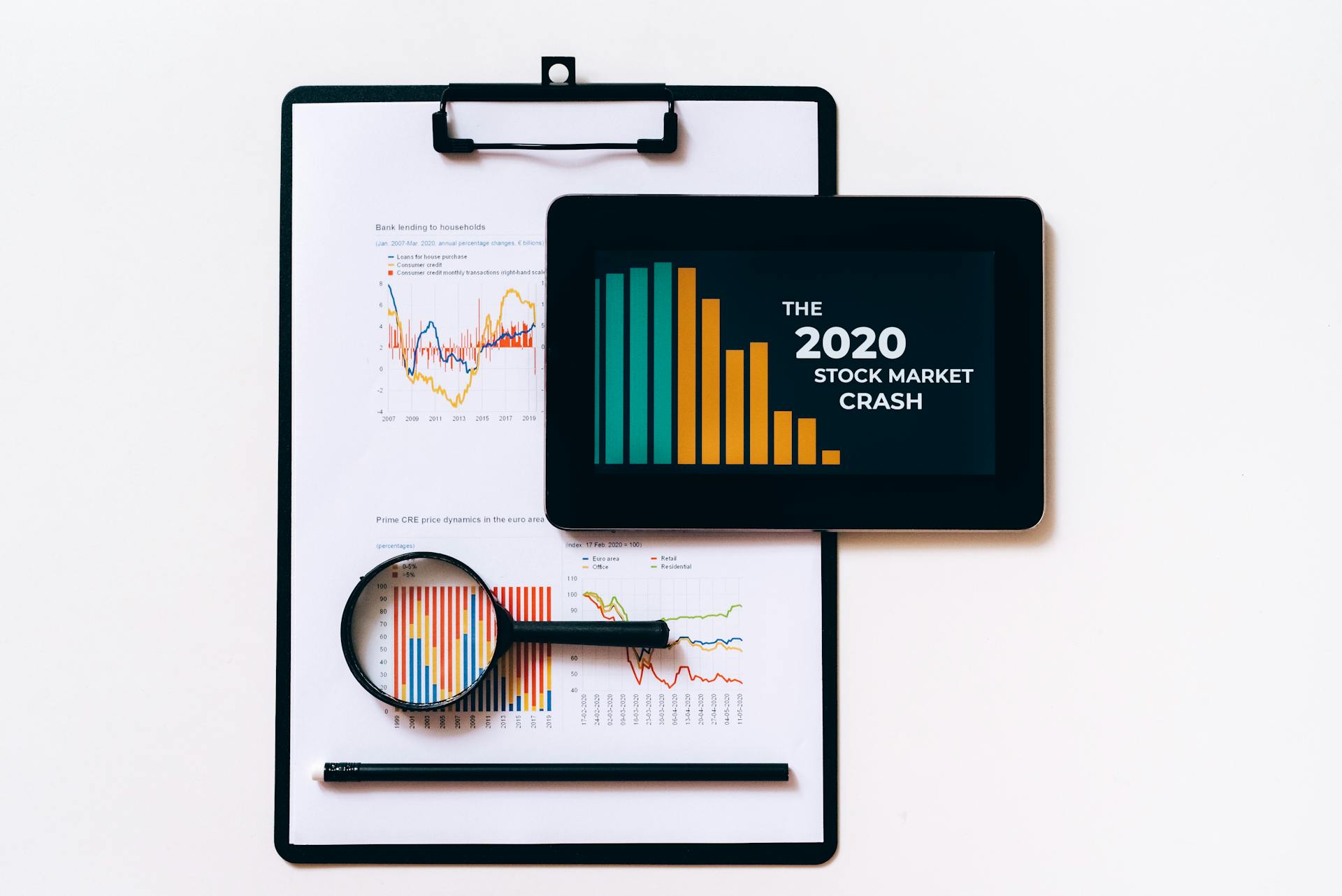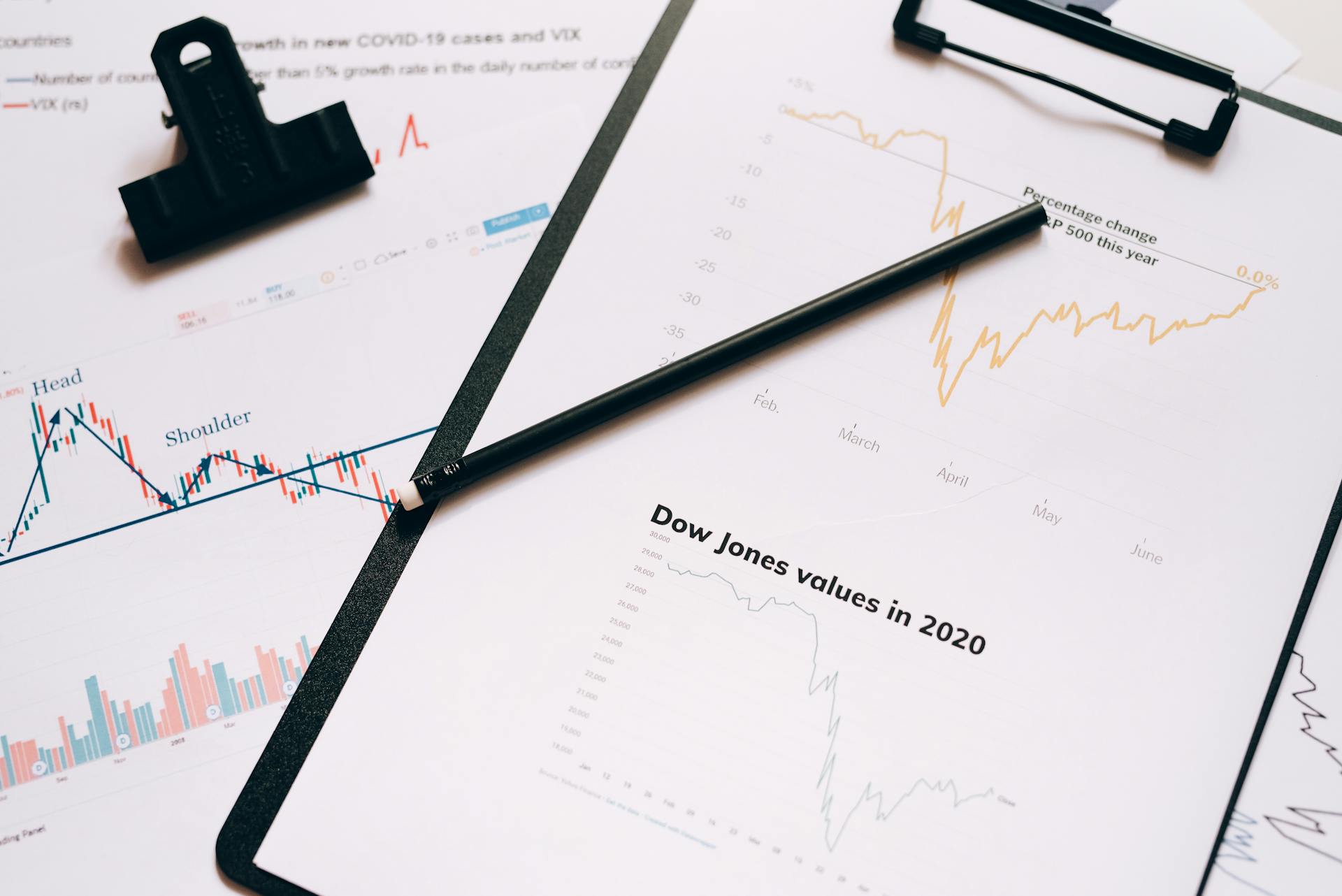
Stock market growth can be a complex topic, but at its core, it's about the value of companies increasing over time. This can happen when a company's profits rise, making its stock more attractive to investors.
One key factor in stock market growth is the economy's overall health. A strong economy with low inflation and high employment rates can lead to increased consumer spending and business investment, driving up stock prices.
The stock market also responds to company-specific factors, such as innovative products, efficient management, and strategic partnerships. For instance, a company that develops a game-changing product can see its stock value soar as investors pile in.
A company's financial performance is another crucial factor in stock market growth. A company's ability to consistently generate profits and pay dividends can make its stock more attractive to investors.
A unique perspective: Investing Business Profits in Stock Market
What Is a Stock?
A stock is a type of investment that represents ownership in a company.
To be more specific, a growth stock is a type of stock that increases its earnings faster than the average business in its industry or the market as a whole.
Growth stocks are often companies with innovative products or services that are gaining share in existing markets or entering new ones.
These companies tend to be more expensive than the average in terms of profitability ratios like price-to-earnings, price-to-sales, and price-to-free cash flow ratios.
Despite their premium price tags, the best growth stocks can still deliver fortune-creating returns to investors when they fulfill their growth potential.
However, growth stocks can be much more volatile than other types of stocks, and downturns can give long-term investors a buying opportunity when growth stock prices are low.
Explore further: Private Equity Investments for Small Investors
Investing Basics
Investing lets you take money you're not spending and put it to work for you, earning compound interest over time. This can turn modest savings into larger nest eggs.

You don't necessarily have to research individual companies and buy and sell stocks on your own to become an investor. In fact, research shows that this approach is unlikely to earn you consistent returns. The average investor can probably get away with a few low-fee index funds.
A starting balance, or principal, is your jumping-off point for investing. Most brokerage firms require a starting balance of a few hundred dollars to $1,000 or more. You can buy individual equities and bonds with less than that, though.
Common financial investments include stocks, index funds, exchange-traded funds (ETFs), and mutual funds. These can be used to reach long-term goals, such as buying a home, saving for a child's education, or putting away enough money for retirement.
Here are some common financial investments:
- Stocks: shares of a company that can increase in value as a company grows.
- Index funds: a portfolio of stocks or bonds that tracks a market index.
- Exchange-traded funds (ETFs): a diversified investment that tracks the returns of a market index and can be traded.
- Mutual funds: a collection of stocks, bonds, and other securities bundled and traded as one investment.
What Is a Stock?
A stock represents ownership in a company, giving you a claim on its assets and profits.
Growth stocks are a type of stock that increase their earnings faster than the average business in their industry or the market as a whole.
Take a look at this: Buy Berkshire Hathaway B Shares

High-growth stocks tend to be more expensive than the average in terms of profitability ratios, such as price-to-earnings, price-to-sales, and price-to-free cash flow ratios.
The best growth stocks can still deliver fortune-creating returns to investors when they fulfill their awesome growth potential.
Growth stocks can be much more volatile, taking a beating in the market, like they did in 2022, and taking longer to recover than the overall market.
High inflation puts pressure on growth stocks by reducing the future value of their expected earnings.
Supply chain constraints and other macroeconomic factors can slow the entire economy, affecting growth stocks' ability to expand.
Explore further: Palantir Stock Price Growth Potential
Finding Stocks
You can't directly invest in the S&P 500, but it's a great benchmark to gauge the overall market performance.
Investing in individual stocks requires research, and it's essential to understand the process of finding great stocks. To find growth stocks, you'll need to identify powerful long-term market trends and the companies best positioned to profit from them.

Narrowing your list to businesses with strong competitive advantages is crucial for long-term success. This means looking for companies that have a unique product or service that sets them apart from the competition.
You'll also want to invest in businesses with large addressable markets and long runways for growth still ahead. Industry reports from research firms like Gartner and Insider Intelligence can provide valuable estimates of industry sizes, projections for growth, and market share figures.
To get started, consider the following steps:
- Identify powerful long-term market trends and the companies best positioned to profit from them.
- Narrow your list to businesses with strong competitive advantages.
- Further narrow your list to companies with large addressable markets.
Remember, the larger the opportunity, the larger a business can ultimately become. And the earlier in its growth cycle it is, the longer it can continue to grow at an impressive rate.
How to Invest
To start investing, you'll need to decide on a starting balance, which is the amount of money you'll begin with. Most brokerage firms require a starting balance of a few hundred dollars to $1,000 or more.

You can start with a small amount of money, such as a bonus from work or money received as a gift or inheritance. This sum can become your investing principal.
Investing lets you take money you're not spending and put it to work for you. Money you invest in stocks and bonds can help companies or governments grow, while earning you compound interest.
The average investor who doesn't have a lot of time to devote to financial management can probably get away with a few low-fee index funds. These funds are a portfolio of stocks or bonds that tracks a market index.
Common financial investments include stocks, index funds, exchange-traded funds (ETFs), and mutual funds. Stocks are shares of a company that can increase in value as a company grows. Index funds and ETFs tend to have lower expenses and fees when compared with actively managed funds.
Here are some common types of investments:
- Stocks: Individual shares of a company
- Index funds: A portfolio of stocks or bonds that tracks a market index
- Exchange-traded funds (ETFs): A diversified investment that tracks the returns of a market index and can be traded
- Mutual funds: A collection of stocks, bonds, and other securities bundled and traded as one investment
You can buy individual equities and bonds with less than $1,000, though most brokerage firms require a starting balance of a few hundred dollars to $1,000 or more for mutual funds and index funds.
What Is a Good Investment?

A good investment is one that generates a good return on investment, or ROI. You invest to get a return, so what makes a good ROI?
A good ROI is typically considered to be 7-10% or higher. This means that for every dollar you invest, you can expect to earn at least 7-10 cents in interest or profit.
The key is to find investments that offer a higher ROI than what you could get from a savings account or other low-risk investments. This might require a bit more risk, but it could also lead to bigger rewards.
To give you a better idea, a 7-10% ROI is considered good because it's higher than the average interest rate on a savings account.
Worth a look: Top 10 Most Expensive Stock Shares
Understanding Stock Market Growth
The stock market has undergone significant changes over the years, with its sector makeup shifting dramatically.
In 1957, Industrials represented over 40% of the S&P 500 index. This is a stark contrast to today's market.

The 1970s saw a brief dominance of Energy companies during the oil crisis. This highlights the impact of global events on the market.
The technology sector has reached historic highs, exceeding 25% of market cap in the 2020s. This is a testament to the growing importance of technology in our economy.
Here's a brief look at the changes in the S&P 500's sector makeup over the years:
The History of
The S&P 500 has been through its fair share of ups and downs, with each major decline followed by an eventual recovery.
The index climbed steadily from 1957 to 1969, reaching about 800 points, reflecting America's growing industrial might and rising middle class.
The S&P 500 faced strong headwinds during the stagflation period of 1970-1981, dropping below 360 points.
The index had its worst fall during the Great Recession of 2007-2009, dropping nearly 57% from October 2007 to March 2009.
The market entered its longest bull run in history after 2009, rising 330% over 10 years.
Curious to learn more? Check out: Global X Autonomous & Electric Vehicles Etf

Here's a brief timeline of the S&P 500's major declines and recoveries:
The S&P 500's sector makeup has also undergone significant changes over the years, with the technology sector reaching historic highs, exceeding 25% of market cap in the 2020s.
Ai
Companies have poured billions into accelerating their AI development and applying it to their businesses, with Nvidia being a big beneficiary since it designs the chips used to train many large language models.
Nvidia's design of chips for large language models has been a key factor in its success.
Alphabet, Amazon, and Microsoft also benefit from growth in AI applications since many run on their cloud computing platforms.
Salesforce is leveraging its position in enterprise software to help companies use their own data to create AI-powered agents.
The key is to try investing in these trends and companies as early as possible, giving you a chance to profit from their growth.
Some of these trends can last for many years, even decades, giving you plenty of time to claim your share of the profits they create.
For more insights, see: Nvidia Ai Stock Growth
Factors Affecting Stock Market Growth

Inflation can significantly impact your stock market returns, and it's essential to understand this factor. The long-term average annual returns from the S&P 500 are around 10.06%, but after adjusting for inflation, the real return drops to about 6.78%.
Investing at the right time can also make a big difference. Investors who bought shares in the SPDR S&P 500 ETF Trust in 2014 saw significant appreciation in value over the next decade.
The concentration of influence from a few major companies can also affect your returns. If a few major companies have a rough year, it can greatly impact your overall returns.
Check this out: Global X Data Center Reits & Digital Infrastructure Etf
Inflation Affects
The long-term average annual returns from the S&P 500 over the last century is 10.06%, but this number doesn't tell the whole story. After adjusting for inflation, the real return drops to about 6.78%.
Inflation can significantly impact the purchasing power of your money, even if it's growing in value. For instance, if you invested $100 in the S&P 500 at the beginning of 1973, you would have about $18,940.81 at the end of 2024, but if you adjust for inflation, that's approximately 2,567.20% cumulatively, or 6.59% per year.
For more insights, see: Inflation Index Etf

The average annualized returns for the S&P 500 over different time frames are also affected by inflation. For example, over the last 10 years, the average return was 12%, but after adjusting for inflation, it was 10.83%. Over 30 years, the average return was 9.03%, but the inflation-adjusted return was 7.46%.
Additional reading: Average Stock Market Return
Timing Affects
Investing in the stock market can be a rollercoaster ride, and timing is everything. Investors who bought shares in the SPDR S&P 500 ETF Trust (SPY) in 2014 saw significant appreciation in value a decade later.
Trying to time the market can be a recipe for disaster. Many financial advisors recommend dollar-cost averaging, which involves investing a fixed amount periodically, no matter the market conditions. This strategy helps avoid the risk of investing all your money at market peaks.
Investors who buy during market lows and hold their investment or sell at market highs will experience larger returns than those who buy during market highs. This is evident from the chart showing the effect of using dollar-cost averaging for the period starting in 2004, which demonstrates significant growth despite market crises.
A fresh viewpoint: Types of Investors in Stock Market

The longer you have to invest, the more time you have to take advantage of the power of compound interest. Starting to invest at the beginning of your career can make a huge difference in your returns.
Here are some key takeaways to keep in mind:
- Investing during market lows can lead to larger returns.
- Dollar-cost averaging can help avoid the risk of investing all your money at market peaks.
- Starting to invest early can make a huge difference in your returns.
Risk for Investments
As you get closer to retirement, your investment portfolio becomes more vulnerable to dips in the market. The conventional wisdom is that older investors should reduce their exposure to risk by shifting some of their investments from stocks to bonds.
Investments with higher potential for return also have higher potential for risk. This is a fundamental trade-off in investing.
Finding the right balance between risk and return depends on your age and risk tolerance.
A different take: Stock Splits with Growth Potential
Frequently Asked Questions
How much has the stock market gone up in 2024?
As of 2024, the Nasdaq Composite has risen over 30%, while the S&P 500 and Dow Jones Industrial Average have seen gains of 25% and 14% respectively. Stock market performance varies by index, but overall, 2024 has been a strong year for investors.
Sources
- https://www.investopedia.com/ask/answers/042415/what-average-annual-return-sp-500.asp
- https://smartasset.com/investing/investment-calculator
- https://www.fool.com/investing/stock-market/types-of-stocks/growth-stocks/
- https://www.fool.com/investing/how-to-invest/stocks/average-stock-market-return/
- https://www.morganstanley.com/ideas/india-election-stock-outlook
Featured Images: pexels.com

